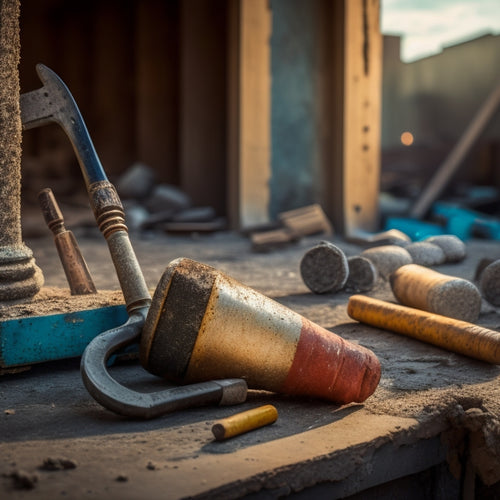
Gas Powered Splitting Tools for Concrete Removal
Share
You'll need a gas-powered splitting tool that can deliver high torque and precision to efficiently remove concrete, whether you're dealing with thick slabs, foundations, or blocks. Consider the type of concrete, block size, and precision level you need when selecting a splitter, as tools vary in design for heavy-duty or lighter applications. Leading brands like Husqvarna, DeWalt, and Makita offer advanced features such as adjustable choke valves and anti-vibration handles to enhance performance. By choosing the right tool and understanding its capabilities, you'll be well on your way to tackling your concrete removal project with confidence and precision.
Key Takeaways
• Consider concrete type, block size, and precision level when selecting a gas powered splitting tool for concrete removal tasks.
• Leading brands like Husqvarna, DeWalt, and Makita offer advanced features like adjustable choke valves and anti-vibration handles for enhanced performance.
• High-torque tools with 40-60 ft-lbs of torque are ideal for thicker, harder concrete slabs and foundations, with adjustable torque settings for varying concrete densities.
• Regular maintenance, including cleaning and lubrication, is critical for the performance and lifespan of gas powered splitting tools.
• Selecting the appropriate tool and bit, along with proper operation techniques, is vital for efficient concrete removal and maintaining control.
Gas Powered Block Splitter Options
You'll find several gas powered block splitter options on the market, each designed to tackle specific concrete removal tasks with varying degrees of power and precision.
When selecting a gas powered block splitter, you'll need to take into account factors such as the type of concrete you'll be working with, the size of the blocks, and the level of precision required.
Top block splitter brands like Husqvarna, DeWalt, and Makita offer a range of gas splitter features, including adjustable choke valves, anti-vibration handles, and optimized piston designs. These features enable you to fine-tune your splitting process, reducing fatigue and increasing productivity.
Some gas powered block splitters are designed for heavy-duty use, with high-powered engines and durable components, while others are more suited for lighter applications.
High-Torque Concrete Splitting Tools
When tackling thicker, harder concrete slabs and foundations, high-torque concrete splitting tools become the go-to solution, offering the extra muscle needed to efficiently break apart stubborn materials. You'll want to opt for tools that deliver high torque performance, typically in the range of 40-60 ft-lbs, to effectively split concrete with minimal effort.
When selecting a high-torque concrete splitting tool, pay close attention to the torque specifications. Look for tools with adjustable torque settings to accommodate varying concrete densities and thicknesses. This feature allows you to fine-tune the tool's performance to match the demands of the job, ensuring ideal results and reduced wear on the equipment.
Furthermore, consider the type of cylinder used in the tool. A high-torque tool typically features a larger cylinder, which generates more force and enables you to split thicker concrete.
Additionally, some tools may come equipped with advanced features, such as automatic lubrication systems, to extend the tool's lifespan and reduce maintenance needs. By choosing the right high-torque concrete splitting tool, you'll be well-equipped to tackle even the most challenging concrete removal projects.
Heavy-Duty Demolition Equipment Needs
For heavy-duty demolition projects, contractors require equipment that can withstand the rigors of frequent, high-intensity use, particularly when tackling massive concrete structures or foundations.
You need tools that can deliver consistent, reliable performance to guarantee efficient demolition techniques. A vital aspect of achieving this is equipment maintenance. Regular servicing is essential to prevent breakdowns, reduce downtime, and extend the lifespan of your tools. This includes routine checks on fuel systems, lubrication, and hydraulic components.
Additionally, you should implement a scheduled maintenance program to replace worn or damaged parts, making sure your equipment remains in peak condition. By doing so, you'll minimize the risk of costly repairs and maximize your return on investment.
When selecting heavy-duty demolition equipment, look for manufacturers that provide all-encompassing maintenance support, including training, spare parts, and technical assistance. This will enable you to enhance your equipment's performance, reduce operational costs, and complete projects efficiently.
Concrete Demolition Safety Considerations
As you prepare to tackle concrete demolition projects, guaranteeing the safety of your crew and surrounding structures becomes a top priority. This requires adherence to strict guidelines and protocols to minimize the risk of accidents and injuries.
You must take a proactive approach to identify potential hazards and implement measures to mitigate them. This includes conducting thorough site preparation, such as clearing the area of debris and obstructions, and guaranteeing that all necessary permits and approvals are in place.
Personal protective equipment (PPE) is also essential, as it provides a critical layer of defense against flying debris, dust, and other hazards. Make sure your crew is equipped with hard hats, safety glasses, ear protection, gloves, and respiratory protection, as needed.
Additionally, guarantee that all equipment is properly maintained and serviced to prevent mechanical failures that could lead to accidents.
Tool Selection for Efficient Removal
You'll need to choose the right tools for the job to guarantee efficient concrete removal, and gas-powered splitting tools are often a top pick for their ability to deliver high levels of force and precision. When selecting a tool, consider the type of concrete you're working with, as well as the size and complexity of the removal project.
Tool Types: Gas-powered breakers, demolition saws, and rotary hammers are popular options for concrete removal. Each has its strengths and weaknesses, so it's important to choose the right tool for the task at hand.
Operation Techniques: Proper operation techniques are vital for efficient concrete removal. This includes maintaining the correct stance, using the appropriate amount of force, and working in a controlled, methodical manner.
Bit Selection: The type of bit or blade used can greatly impact the efficiency of the removal process. Choose bits or blades specifically designed for concrete removal and suitable for the type of concrete you're working with.
Maintenance: Regular maintenance is critical to guarantee your gas-powered splitting tools remain in top condition. This includes routine cleaning, lubrication, and replacement of worn or damaged parts.
Frequently Asked Questions
Can Gas-Powered Splitting Tools Be Used for Asphalt Removal?
You're wondering if gas-powered splitting tools can tackle asphalt removal. The answer lies in their splitting efficiency.
Designed for controlled demolition, these tools excel at asphalt cutting, making them a viable option.
With their high-torque output, they can effectively split and remove asphalt, especially in areas where traditional methods struggle.
Are Concrete Splitting Tools Suitable for Indoor Demolition Projects?
When considering indoor demolition projects, you need to prioritize indoor safety and ventilation requirements.
You'll want to guarantee that the tools you choose won't compromise air quality or create hazardous conditions.
In this case, concrete splitting tools can be suitable, but only if they're electric or pneumatic, and you've implemented proper ventilation systems to minimize dust and debris dispersal.
How Often Should I Maintain My Gas-Powered Concrete Splitter?
When you invest in a powerful tool, you need to maintain it to guarantee peak performance.
You should establish a regular maintenance schedule to keep your equipment in top condition. Check the operator's manual for specific guidelines, but as a general rule, you'll want to inspect and clean the tool after each use, and perform more thorough maintenance every 1-3 months.
Follow these performance tips to maximize efficiency and extend the tool's lifespan.
Can I Rent Gas-Powered Concrete Splitting Equipment Instead of Buying?
When considering equipment acquisition, you're weighing the option to rent instead of buy. This approach offers rental advantages, such as reduced upfront costs and minimal storage needs.
However, you'll need to factor in cost considerations, including rental fees, potential delivery charges, and the possibility of equipment unavailability.
Carefully assess your project's duration and frequency of use to determine if renting is the most cost-effective solution for you.
Do Gas-Powered Concrete Splitters Require Special Operator Training?
When you're handling powerful machinery, it's like wielding a precision scalpel - you need the right touch to avoid causing harm.
When it comes to operating gas-powered concrete splitters, you'll want to guarantee you're properly trained to follow safety protocols and obtain operator certification.
This isn't just a recommendation, it's a necessity to prevent accidents and guarantee the job gets done efficiently.
Conclusion
As you prepare to tackle that concrete removal project, you've got the know-how to choose the right gas powered splitting tool for the job.
You've weighed the options, considered the risks, and are ready to take on the task at hand.
But, can you handle the raw power and precision of these high-torque machines?
The fate of your project hangs in the balance - will you emerge victorious, or will the concrete prevail?
Related Posts
-

Top DIY Concrete Grinding and Polishing Tools
When selecting DIY concrete grinding and polishing tools, you'll want to take into account a range of factors to guar...
-

Essential Power Tools for DIY Concrete Sculpting
As you begin DIY concrete sculpting, you'll need a strategic selection of power tools to achieve professional-grade r...
-

5 Tips for Splitting Concrete With Second-Hand Tools
When splitting concrete with second-hand tools, you'll need to be strategic to avoid wasting time, money, and putting...


